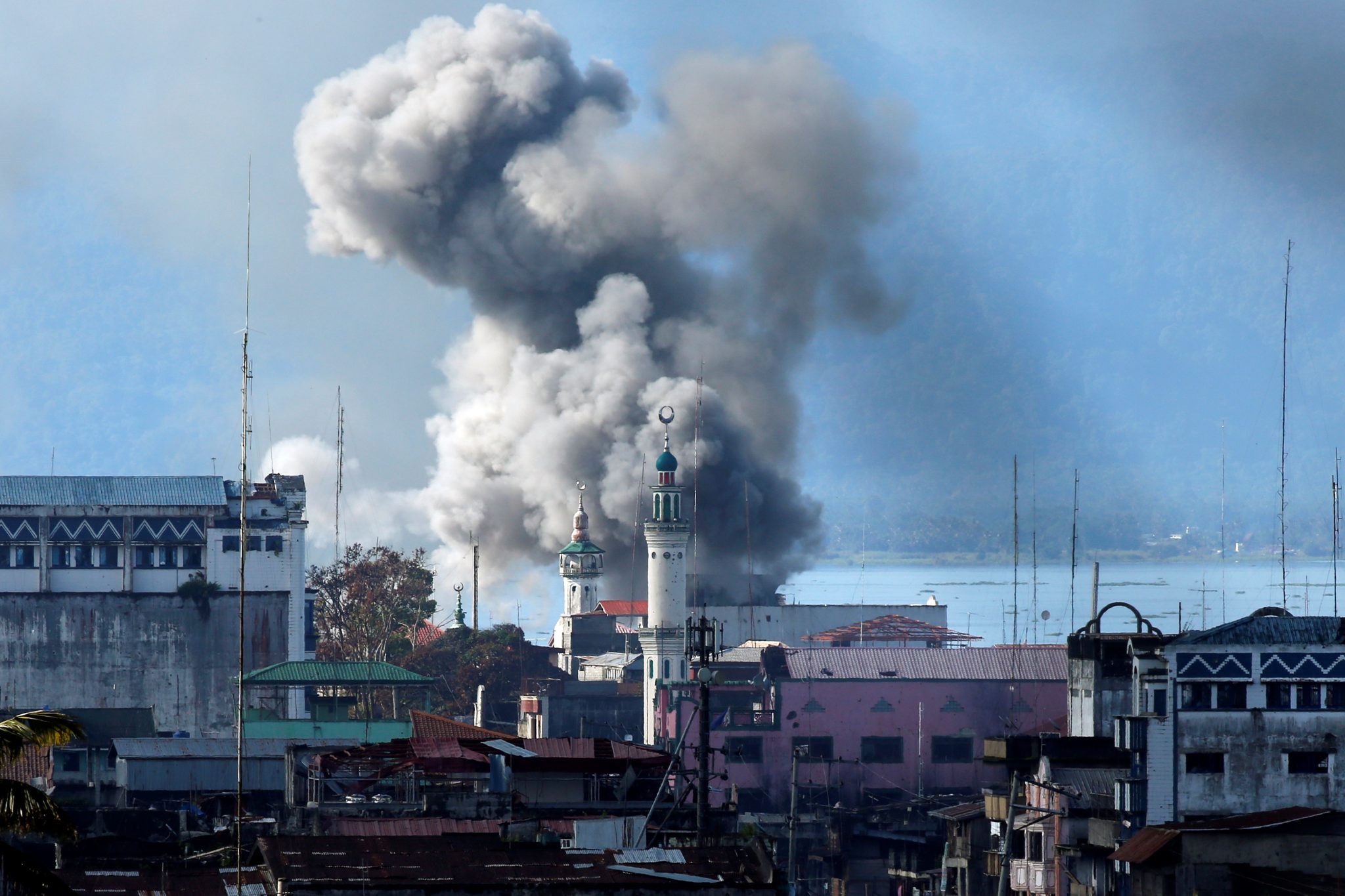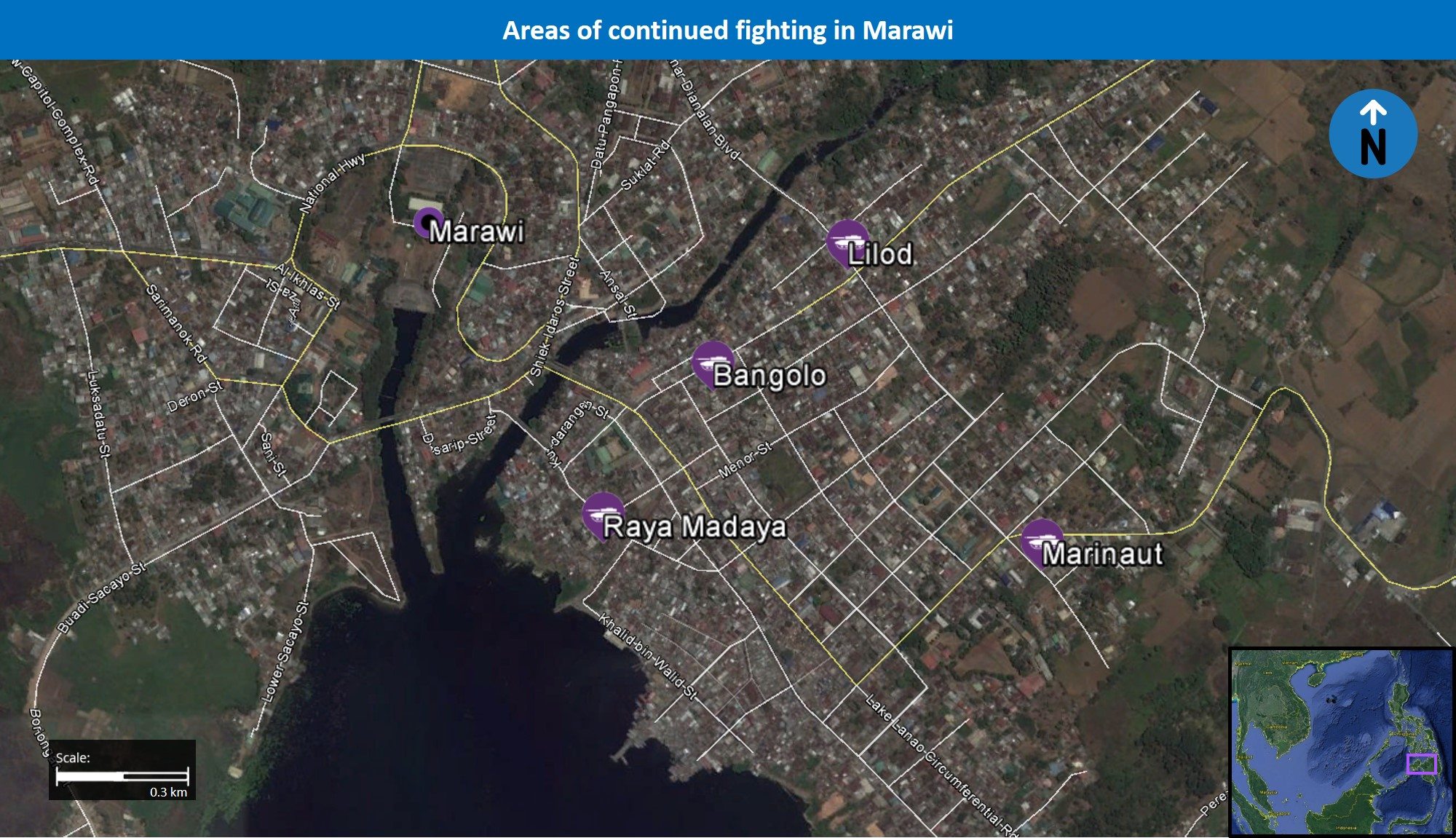Current Situation
On June 23, an AFP spokesperson stated that following the initial rounds of heavy fighting in Marawi that began on May 23, only Bangolo, Marinaut, Raya Madaya and Lilod remain contested. Overall, the AFP estimates that approximately 225 militants and 50 soldiers have been killed since the operation commenced, along with another 26 civilians. A brief eight-hour ceasefire between the AFP and Maute fighters occurred in Marawi on June 25, during which time delegates met to discuss the issue with the remaining hostages in the city, believed to still be numbering at around 150.
Meanwhile, Isnilon Hapilon, a senior figure in the siege and leader of the Islamic State (IS)-linked Abu Sayyaf group, is believed to have fled the city as of June 24. Reports indicating the death of senior commander Omar Maute and chief financier Mahmud bin Ahmad, a Malaysian national, remain unverified. These potential losses, as well as intelligence suggesting infighting and divisions among the remaining leadership, has led the AFP to label the remaining militant force as “crumbling” on June 26, and that victory is “irreversible”.
In addition to the involvement of 21 Malaysian individuals, a leaked Philippine intelligence report from June 24 indicated the presence of 28 Indonesians, 26 Pakistanis, four “Arabs”, three Bangladeshis, one Indian-Singaporean, and one Singaporean during the course of the siege. Reports from June 14 also showed the presence of US forces outside of Marawi, which an AFP spokesman later clarified as serving a non-combat operational assistance role, largely related to reconnaissance. On June 23, further reports surfaced over Australia offering to send more surveillance aircrafts to Mindanao to aid AFP efforts.
Philippine Vice President Leni Robredo visited camps set up outside of Marawi for displaced persons on June 26, with President Rodrigo Duterte remaining in an unknown location or personal state for six days, fueling renewed speculation by the press that he was suffering health problems. On June 17, President Duterte made an appearance after an absence that had also been six days long, reportedly responding with a vulgar joke after reporters asked him about the state of his health.
Assessments & Forecast
Despite projected confidence from AFP, no timeline for complete victory has been defined
It continues to remain difficult to gauge overall progress by the AFP in retaking the city. While only four areas remain in contention, fighting has been present there since around the opening days of the offensive. Moreover, the considerable presence of hostages will continue complicating efforts to fully drive out the militants as forces continue to consolidate in these remaining districts. Further compounding these issues, the AFP statements suggesting strong confidence for a dissolving militant hierarchy and an imminent victory appear to rely on unverified information. Although there are no indicators that the AFP will not eventually clear out the city, similar statements of imminence have been previously made regarding Marawi that have yet to be realized, and as such, are not accurate indicators of on-the-ground progress.
Additionally, as the AFP continues to make headway, the risk of infiltration into surrounding territories becomes elevated. The AFP has made a number of statements over the weeks suggesting an acute awareness of this fact, likely meaning that security deployments to the immediate areas around Marawi will continue to be bolstered over the coming weeks. That being said, Hapilon’s reported exfiltration suggests that security gaps nonetheless exist to be exploited.
Meanwhile, President Duterte is known to be an energetic and forceful figure, and his continued absence in the face of this exhaustive crisis remains highly conspicuous. The Palace has remained tight-lipped over President Duterte’s frequent disappearances over the month of June and with Duterte himself offering little information to the press, this may prove to be damaging to his popularity and brand, which has continually emphasized his strongman character. However, the issue of his inconsistent appearances is unlikely to have an impact on military operations in Marawi, as the AFP is relatively compartmentalized from the central government.
Involvement of foreign fighters underscores expansion of regional militant nexus
The involvement of foreign fighters in the siege reconfirms our ongoing assessment of a regional militant nexus of IS sympathizers and fighters using the poorly-policed eastern Malaysian and Indonesian waters to move to and from the Philippines’ Sulu Archipelago. However, the involvement of individuals from as far as Pakistan and Bangladesh suggest that this nexus is more far-reaching than has been initially anticipated. Whereas traveling to fight in Syria and Iraq becomes more dangerous, especially considering the mounting losses that IS faces in the Middle East, it increasingly appears that aspiring militants may choose to instead travel to fight in Southeast Asia, and namely in the Philippines, where a relatively strong infrastructure already exists.
Moreover, the realization of a larger, potentially global militant convergence may be in part responsible for the participation of the US and Australian forces, who are likely eager to limit the growing trend. At this point, the actual extent of the involvement of Australian and US forces is unclear, especially after photographs emerged allegedly depicting unidentified Americans carrying combat gear but wearing civilian clothing. This is likely in line with the government’s desire to control the narrative of the conflict and project capabilities that they may not necessarily possess independently, in line with similar posturing that has been witnessed over the past month.
Recommendations
Travel to Metro Manila may continue at this time while adhering to standard security protocols given the latent threat of militancy, crime, and unrest. We continue to advise against all travel to Lanao del Sur (including Marawi),the Autonomous Region in Muslim Mindanao (ARMM), Cotabato, Lanao del Norte,, Zamboanga del Norte, Zamboanga Siburgay, Zamboanga del Sur, and the Sulu Archipelago, including the islands of Basilan, Jolo, Tawi Tawi, given the high threat of militancy and the elevated risk of kidnapping of foreign travelers. Avoid nonessential travel to all of Mindanao. If business is essential on the island of Mindanao, we advise to minimize movement in areas outside of major cities and maintain heightened vigilance .


